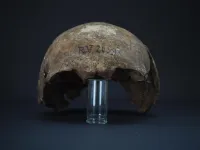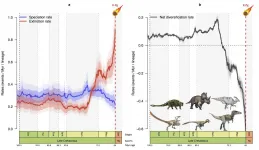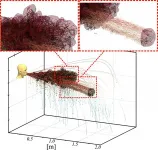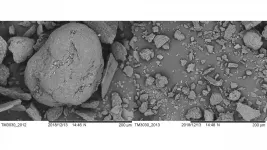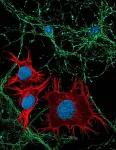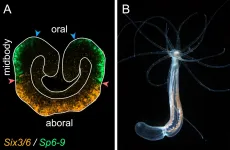(Press-News.org) The oldest strain of Yersinia pestis--the bacteria behind the plague that caused the Black Death, which may have killed as much as half of Europe's population in the 1300s--has been found in the remains of a 5,000-year-old hunter-gatherer. A genetic analysis publishing June 29 in the journal Cell Reports reveals that this ancient strain was likely less contagious and not as deadly as its medieval version.
"What's most astonishing is that we can push back the appearance of Y. pestis 2,000 years farther than previously published studies suggested," says senior author Ben Krause-Kyora, head of the aDNA Laboratory at the University of Kiel in Germany. "It seems that we are really close to the origin of the bacteria."
The plague-carrying hunter-gatherer was a 20- to 30-year old man called "RV 2039." He was one of two people whose skeletons were excavated in the late 1800s in a region called Rinnukalns in present-day Latvia. Soon after, the remains of both vanished until 2011, when they reappeared as part of German anthropologist Rudolph Virchow's collection. After this re-discovery, two more burials were uncovered from the site for a total of four specimens, likely from the same group of hunter-fisher-gatherers.
Krause-Kyora and his team used samples from the teeth and bone of all four hunter-gatherers to sequence their genomes and then tested them for bacterial and viral pathogens. They were surprised to find evidence of Y. pestis in RV 2039--and after reconstructing the bacteria's genome and comparing it to other ancient strains, the researchers determined that the Y. pestis RV 2039 carried was indeed the oldest strain ever discovered. It was likely part of a lineage that emerged about 7,000 years ago, only a few hundred years after Y. pestis split from its predecessor, Yersinia pseudotuberculosis.
"What's so surprising is that we see already in this early strain more or less the complete genetic set of Y. pestis, and only a few genes are lacking. But even a small shift in genetic settings can have a dramatic influence on virulence," says Krause-Kyora.
In particular, this ancient strain lacked one crucial thing: the gene that first let fleas act as vectors to spread the plague. This gene was responsible for efficient transmission of the bacterium to human hosts, which resulted in the growth of the infamously grotesque pus-filled buboes in the sick associated with the medieval bubonic plague. Flea-based transmission also required the death of the human host, which means that the appearance of the gene could have driven the evolution of a deadlier disease.
From RV 2039, it likely took more than a thousand years for Y. pestis to acquire all the mutations needed for flea-based transmission. And it's not clear to what extent RV 2039 experienced the effects of the plague at all.
Y. pestis was found in his bloodstream, meaning he most likely died from the bacterial infection--although, the researchers think the course of the disease might have been fairly slow. They observed that he had a high number of bacteria in his bloodstream at his time of death, and in previous rodent studies, a high bacterial load of Y. pestis has been associated with less aggressive infections. Additionally, the people he was buried near were not infected and RV 2039 was carefully buried in his grave, which the authors say also makes a highly contagious respiratory version of the plague less likely.
Instead, this 5,000-year-old strain likely was transmitted directly via a bite from an infected rodent and probably didn't spread beyond the infected person. "Isolated cases of transmission from animals to people could explain the different social environments where these ancient diseased humans are discovered. We see it in societies that are herders in the steppe, hunter-gatherers who are fishing, and in farmer communities--totally different social settings but always spontaneous occurrence of Y. pestis cases," says Krause-Kyora.
These conclusions--that the early form of Y. pestis likely was a slow-moving disease and wasn't very transmissible--challenge many theories about the development of human civilization in Europe and Asia. For example, some historians have suggested that infectious diseases like Y. pestis evolved mostly in megacities of over 10,000 people near the Black Sea. However, 5,000 years ago--the age of RV 2039's strain--was long before the formation of large cities. Instead, agriculture was just beginning to appear in Central Europe, and populations were much sparser.
This timeline, plus the less contagious and deadly nature of this early Y. pestis strain, also contradicts the hypothesis that Y. pestis led to the large population declines in Western Europe at the end of the Neolithic Age.
The authors say that examining the history of Y. pestis could also potentially shed light on human genomic history. "Different pathogens and the human genome have always evolved together. We know Y. pestis most likely killed half of the European population in a short time frame, so it should have a big impact on the human genome," says Krause-Kyora. "But even before that, we see major turnover in our immune genes at the end of the Neolithic Age, and it could be that we were seeing a significant change in the pathogen landscape at that time as well."
INFORMATION:
This work was supported by the Deutsche Forschungsgemeinschaft (DFG, German Research
Foundation) and Germany`s Excellence Strategy. The anthropological and archaeological research on Ri??ukalns is funded by the DFG and the University of Latvia.
Cell Reports, Susat et al.: "A 5,000-year-old hunter-gatherer already plagued by Yersinia pestis." https://www.cell.com/cell-reports/fulltext/S2211-1247(21)00645-8
Cell Reports (@CellReports), published by Cell Press, is a weekly open-access journal that publishes high-quality papers across the entire life sciences spectrum. The journal features reports, articles, and resources that provide new biological insights, are thought-provoking, and/or are examples of cutting-edge research. Visit: http://www.cell.com/cell-reports. To receive Cell Press media alerts, contact press@cell.com.
Ten million years before the well-known asteroid impact that marked the end of the Mesozoic Era, dinosaurs were already in decline. That is the conclusion of the Franco-Anglo-Canadian team led by CNRS researcher Fabien Condamine from the Institute of Evolutionary Science of Montpellier (CNRS / IRD / University of Montpellier), which studied evolutionary trends during the Cretaceous for six major families of dinosaurs, including those of the tyrannosaurs, triceratops, and hadrosaurs. Using a novel statistical modelling method that limited bias associated with gaps in the fossil record, they demonstrated that, for dinosaurs 76 million years ...
WASHINGTON, June 29, 2021 -- Computer simulations have been used with great success in recent months to visualize the spread of the COVID-19 virus in a variety of situations. In Physics of Fluids, by AIP Publishing, researchers explain how turbulence in the air can create surprising and counterintuitive behavior of exhaled droplets, potentially laden with virus.
Investigators from the University of Florida and Lebanese American University carried out detailed computer simulations to test a mathematical theory they developed previously. They found nearly identical exhalations could spread in different ...
WASHINGTON, June 29, 2021 -- As pervasive as they are in everyday uses, like encryption and security, randomly generated digital numbers are seldom truly random.
So far, only bulky, relatively slow quantum random number generators (QRNGs) can achieve levels of randomness on par with the basic laws of quantum physics, but researchers are looking to make these devices faster and more portable.
In Applied Physics Letters, by AIP Publishing, scientists from China present the fastest real-time QRNG to date to make the devices quicker and more portable. The ...
What The Study Did: This study describes four patients who presented with acute myocarditis after mRNA COVID-19 vaccination.
Authors: Raymond J. Kim, M.D., of the Duke Cardiovascular Magnetic Resonance Center in Durham, North Carolina, is the corresponding author.
To access the embargoed study: Visit our For The Media website at this link https://media.jamanetwork.com/
(doi:10.1001/jamacardio.2021.2828)
Editor's Note: The article includes conflict of interest disclosures. Please see the articles for additional information, including other authors, author contributions and affiliations, conflicts of interest and financial disclosures, and funding and support.
INFORMATION:
Media advisory: ...
What The Study Did: Researchers describe myocarditis presenting after COVID-19 mRNA vaccination in 23 patients within the Military Health System.
Authors: Jay Montgomery, M.D., of Walter Reed National Military Medical Center in Bethesda, Maryland, and Margaret Ryan, M.D., M.P.H., of the Naval Medical Center San Diego, are the corresponding authors.
To access the embargoed study: Visit our For The Media website at this link https://media.jamanetwork.com/
(doi:10.1001/jamacardio.2021.2833)
Editor's Note: The article includes conflict of interest disclosures. Please see the articles for additional information, including other authors, author contributions and affiliations, conflicts of interest and financial disclosures, and funding ...
This press release is in support of a presentation by Dr Ruth Howie presented online at the 37th Annual Meeting of ESHRE.
29 June 2021: Cancer treatments can cause premature ovarian failure (POI) including in girls who want to become mothers eventually. Ovarian tissue cryopreservation (OTC) provides a future fertility option but is invasive, has risks and evidence indicates that most girls don't develop POI. So, doctors face the dilemma of how to offer OTC appropriately.
Now, an assessment tool has been found to help predict correctly which female cancer patients aged under 18 years will develop POI and should therefore be offered OTC. Results from a long-term follow-up study of 423 girls and young women show nearly a quarter (24%; n = 9) of the 37 assessed as high ...
WASHINGTON, June 29, 2021 - For more than 60 years, algae have been studied as a potential feedstock for biofuel production, but the cellulose in their cell wall makes it hard to access the critical molecules inside and convert them to biogas.
In the Journal of Renewable and Sustainable Energy, from AIP Publishing, an international research team reports their success in using urea and sodium hydroxide (NaOH, commonly known as lye or caustic soda) as a pretreatment of algae, which breaks down cellulose and more than doubles biogas production under their initial experimental conditions.
"We were ...
With advances in medical science driving progress against childhood brain tumors, today three out of four young patients survive at least five years beyond diagnosis. However, the outcomes look grim when malignant cells spread, or metastasize.
Such is the case with medulloblastoma, a type of brain cancer that arises in the cerebellum, at the back of the head. Although rare in absolute terms -- about 350 cases emerge each year, 60 percent of them in children -- medulloblastoma is the most common and deadliest form of pediatric brain cancer. Metastasis ...
In a new article in Nature Communications, a research group led by Grigory Genikhovich at the University of Vienna has found that the way the main body axis of sea anemones is patterned by different intensities of β-catenin signaling is similar to that of sea urchins and vertebrates. This suggests that this axial patterning mechanism already existed about 650 million years ago.
The positioning of all anatomical structures in an embryo is determined by systems of molecular coordinates, which are called body axes. Different regulatory genes are activated at specific locations along the body axes to drive the development of all body parts in correct places.
This process is very ...
Ludwig-Maximilians-Universitaet (LMU) in Munich researchers have shown how RNA-binding proteins modulate synaptic responses that mediate the transmission of nerve cell impulses.
Cells in the central nervous system possess a high degree of flexibility, which enables them to adapt to fluctuating demands and respond to changing patterns of neuronal activity. This is achieved by modulating the connections between nerve cells, which are mediated by structures called synapses that determine how neighboring neurons respond to stimulation. These adjustments in turn require the intracellular transport of mRNAs. Consequently, the required proteins ...
